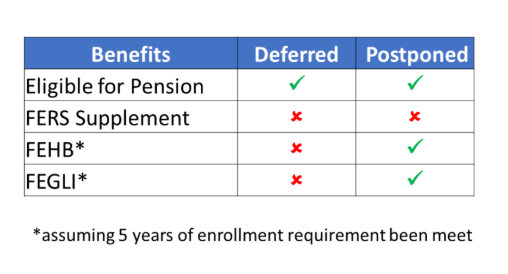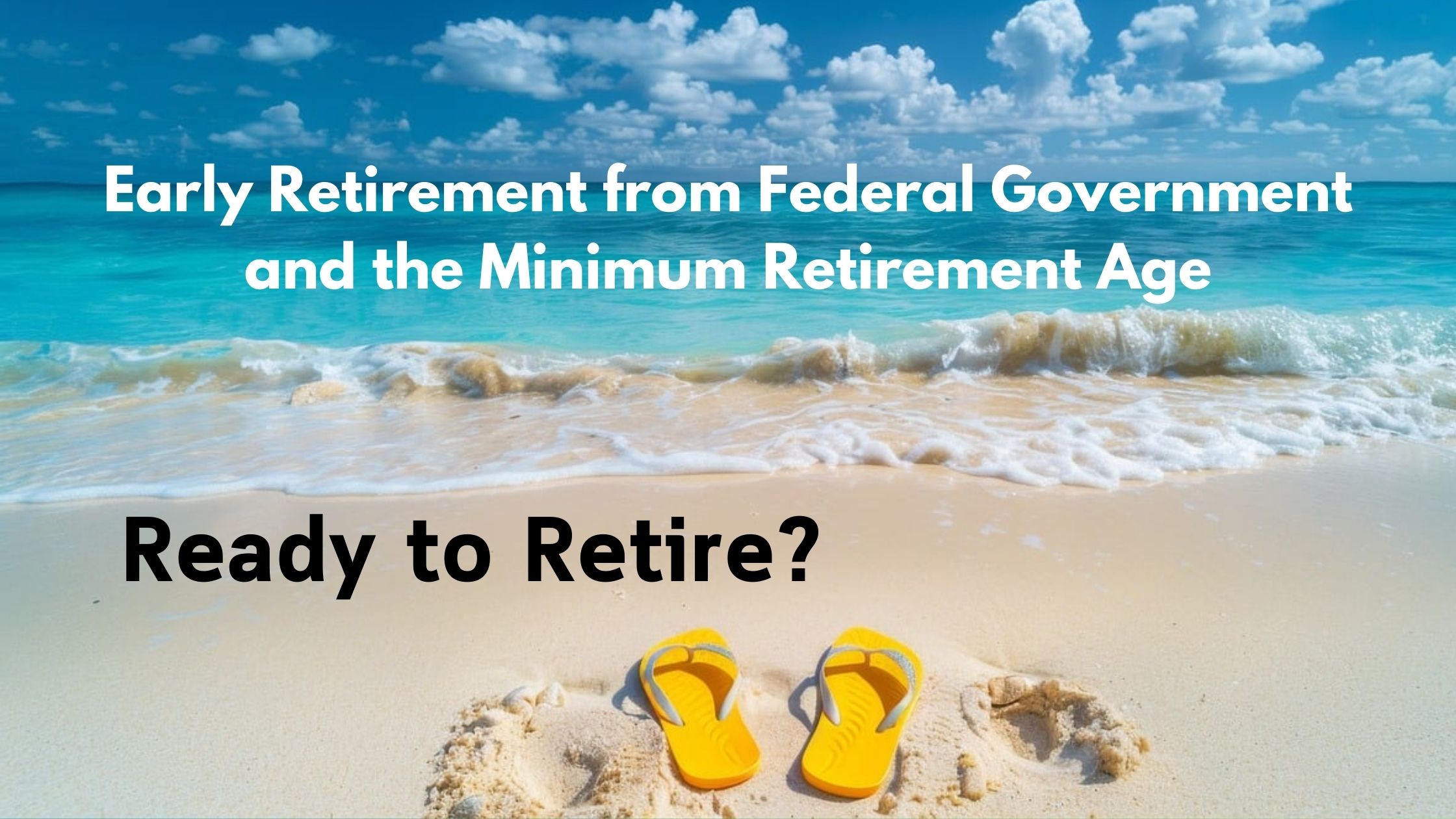Leaving your FERS position before reaching the MRA? Learn about refunded contributions and deferred retirement options for federal employees.
FERS Guide for Federal Employees Leaving Government Job Before Reaching MRA
For federal employees who are part of the Federal Employees Retirement System (FERS), the Minimum Retirement Age (MRA) is an important factor to consider before leaving their job. This guide reviews the definition of MRA, its impact on retirement planning, and the various options available FERS workers exiting their job prior to reaching their MRA.
The Minimum Retirement Age and FERS Service Requirements
What is the Minimum Age for Federal Retirement Eligibility?
The Minimum Retirement Age (MRA) for federal employees under the FERS is the earliest age you can leave your job and collect an immediate retirement benefit (assuming the years of service requirement is also met.) The age is based on the year of birth, ranging from age 55 to 57. For those born in 1966 or earlier, they have already attained the minimum age by the end of 2024. If born in 1970 or later, then your MRA is 57. For individuals born in 1967, 1968, or 1969, see chart below:
| Birth Year | Minimum Retirement Age |
| 1967 | 56 years and 6 months |
| 1968 | 56 years and 8 months |
| 1969 | 56 years and 10 months |
| 1970 or later | 57 |
Start planning your federal retirement now! Sign up for a free federal retirement webinar
Age and Service Requirements for Types of FERS Retirements: Immediate, Postponed, and Deferred
To retire at the MRA with an immediate pension, federal employees must meet specific age and service requirements. Generally, employees must have at least 30 years of service to retire at their MRA. Alternatively, they can retire immediately at age 60 with 20 years of service or at age 62 with at least five years of service. A postponed retirement becomes an option upon reaching one’s MRA with at least 10 years of service. This is commonly referred to as an “MRA+10 Retirement.” The FERS annuity is postponed to age 62 and more benefits can be retained in comparison to a deferred retirement, which is for feds who are leaving the government before their MRA. The annuity can be deferred to age 60 or 61 (with an age reduction penalty) or at 62, but the retiree is ineligible for FEHB and FEGLI regardless of any insurance coverage they had during employment. The social security supplement is only available for those who retire before age 62 with an immediate FERS annuity.

Knowledge is Confidence!
Options for Those who Leave Federal Service Before MRA: Refund Contributions or Defer Retirement
Assuming the 5-year service requirement is met, there are two options for federal employees leaving their job before the minimum age: take refunded contributions or defer the FERS annuity until they are at least age 60. To collect FERS retirement benefits at age 60 or 61, there is a 20-year minimum years of service required and for each month under 62, there’s a 0.416% reduction (5% per year). To take the pension at 60 means a permanent 10% reduction, while doing so at 61 results in a 5% reduction.
| Eligibility Age | Service Requirements | |
|---|---|---|
| Postponed Retirement | MRA or older | 10 to 30 years of service |
| Deferred Retirement | Before MRA | at least 5 years of service |
For refunded FERS contributions, this entails forgoing a federal annuity in retirement for a lump-sum refund of employee contributions to the retirement system. The lump sum (but not the employee contribution portion) is subject to income tax and a possible 10% age-based penalty from the IRS if under age 59.5. The refunded contributions can be rolled over into an IRA to avoid the penalty, but this has to be done within 60 days of the money disbursal. There is also a 20% withholding required on the rollover amount and that needs to be provided from an outside cash supply, which can complicate the IRA roller in regards to taxes. The taxable portion can be rolled over to the TSP to avoid the withholding, however. If you return to federal service later in life, a redeposit can be made to restore the earned FERS contributions. When dealing with at least 1 year of service, both a redeposit amount and a refunded lump-sum will have interest applied based on the rate of US Treasury securities.
Need help planning out your exit from your federal job? Meet with us!
Federal Retirement Planning: How to Calculate FERS Annuity
How Do You Calculate FERS Retirement?
The calculation of a FERS annuity is influenced by several factors, including the employee’s high-3 average salary, years of creditable service, and age at retirement. The high-3 average salary is the highest average basic pay earned during any three consecutive years of federal service. For deferred and postponed retirement benefits, the calculation always uses a 1.0 percent multiplier. If you retire from the federal government and collect an immediate FERS pension at age 62 or older, a 1.1 percent multiplier is used, essentially boosting the FERS retirement benefit by 10%.
Need FERS Calculation to estimate federal pension? Use our FERS Retirement Calculator
Understanding the Retirement Annuity Calculation for FERS Employees
The three components needed to calculate FERS annuity are:
- High-3 Salary
- Years of Service
- Multiplier (1.0% or 1.1%)
The number of years of service is crucial when calculating the amount of a FERS annuity. The more years of creditable service an employee has, the higher their annuity will be. This is because the annuity is calculated as a percentage of the employee’s high-3 average salary, multiplied by their years of service, which is then multiplied by 1.0% (0.01) or 1.1% (0.011). The MRA plays a significant role in determining eligibility for retirement from the US federal government, not so much the calculation itself. An immediate FERS retirement can begin at MRA with 30 years of service and a FERS pension cannot be postponed (MRA+10 retirement) until the federal worker’s MRA is reached with at least 10 years of creditable service under FERS. Deferred retirement is mainly for those with at least 5 years of service who retire at ages below the minimum, which should not be confused a mandatory retirement age. Mandatory age requirement apply to FERS occupations with special retirement provisions, such as federal firefighters, law enforcement officers (LEOs), and air traffic controllers.
Early Voluntary Retirement, Disability, and Special Provisions
Age and Service Exceptions: VERA/VSIP and FERS Disability Retirement
Disability retirement under FERS comes with different rules than a regular FERS retirement. With a minimum service requirement of 18 months, there is no minimum age so long as the impacted individual is unable to perform their job duties due to a medical condition. To qualify for disability retirement, employees must provide medical evidence of their inability to work. When a federal agency loses funding or is phased out of use, the Voluntary Early Retirement Authority (VERA) and Voluntary Early Separation Incentive Payment (VSIP) may offer the federal worker a chance to choose an early retirement. To qualify, an employee must:
- Meet age & service requirements
- Age 50 with 20 years of service, or
- Any age with 25 years of service
- Have served in the position covered by the authorization for a minimum time frame (usually 30 days)
- Serving in a position covered by the agency’s VERA plan
- Retire by the period covered by the VERA
Mandatory Retirement Age for Occupations with Special Provisions
Mandatory retirement applies to certain federal employees, such as LEOs, firefighters, and ATCs, who are required to retire at a specific age due to the physical demands of their positions. LEOs and firefighters face a mandatory retirement at age 57 while it’s 56 for ATCs , although they may retire earlier if they meet the eligibility requirements:
| Years of Service | Retirement Age |
| 20 | MRA |
| 20 | 50 |
| 25 | Any Age |
Federal Retirement Planning Toolkit: FERS Webinar, Pension Calculators, and the Best Financial Advisors for Federal Employees
Federal Retirement Webinar: FERS Workshop
The MRA is a critical component of federal retirement planning because it influences when an employee can start receiving their annuity. This age is a key milestone in retirement planning, as it helps employees and their advisors to strategize the best time to retire, ensuring that they maximize their retirement benefits while considering their financial needs and lifestyle goals. Comparing the pros and cons of your different options is our specialty at PlanWell Financial. We offer a free 20+ page benefit report that provides the information you will need to make an informed choice about your financial future.
Don’t know where to get started? Our online FERS seminar is a great place to get focused on your retirement plan. Sign-up for the free FERS Workshop here.
Financial Advisors and Retirement Calculators to Help Federal Employees Retire Early
Retiring early can have substantial financial implications for federal employees. The reduced annuity means that employees will receive a smaller monthly pension, which can affect their overall financial security in retirement. Additionally, early retirees may need to rely more heavily on other retirement savings or income sources to maintain their desired lifestyle. It is crucial for employees to use retirement calculators and seek advice from financial advisors to understand the full impact of early retirement on their long-term financial plans. Both our FERS calculation tool and Thrift Savings Plan calculator are deigned to help you estimate future income and craft a robust financial plan to achieve your goals. Meet with a Financial Advisor for Federal Employees to learn how we can help!
Reach Out to Us!
If you have additional federal benefit questions, contact our team of CERTIFIED FINANCIAL PLANNER™ (CFP®), Chartered Federal Employee Benefits Consultants (ChFEBC℠), and Accredited Investment Fiduciaries (AIF®). At PlanWell, we are federal employee financial advisors with a focus on retirement planning. Learn more about our process designed for the career fed.
Preparing for federal retirement? Check out our scheduled federal retirement workshops. Sign up for our no-cost federal retirement webinars using this link! Make sure to plan ahead and reserve your seat for our FERS webinar, held every three weeks. Want to have PlanWell host a federal retirement seminar for your agency? Reach out, and we’ll collaborate with HR to arrange an on-site FERS seminar.
Want to fast-track your federal retirement plan? Skip the FERS webinar and start a one-on-one conversation with a ChFEBC today. You can schedule a one-on-one meeting on our contact page.










